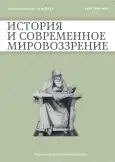The aim of the study is to analyze the maternity rites and traditions of the Mordovian people that existed in the past and are still preserved today, as recorded in the oral-poetic literature, scientific and periodicals, materials collected by the authors during field ethnographic research. The research was based on such methods as comparative-historical, historical-genetic, problem-chronological, structural-systemic, included observation, logical, descriptive-narrative, generalization, classification and systematization. The authors use specific examples to show how diverse, interesting and rational are the rites and traditions of the Mordovian people associated with childbirth and nurture. When analyzing the historiography of the considered topic it is noted that a significant contribution to its development was made by scientific works of such ethnographers as N. F. Mokshin, N. F. Belyaeva, G. A. Kornishina, T. P. Fedyanovich, V. A. Balashov, A. S. Luzgin, E. N. Mokshina, Y. N. Sushkova and others. Conclusions: At present each Mordovian family decides for itself which omens to believe in, which ceremonies to observe, which traditions to follow. However, even if a family perceives maternity rituals of the child cycle as a tribute and does not put into them the meaning their ancestors implied, it still contributes to the preservation of the traditions and culture of the Mordovian ethnos. The revival of the institute of a strong large family at the present stage could significantly help to solve the demographic problem extremely urgent for the Mordovian people.
 9-14
9-14


 15-23
15-23


 24-32
24-32


 33-40
33-40


 41-45
41-45


 46-50
46-50


 51-57
51-57


 67-72
67-72


 58-66
58-66


 73-76
73-76










